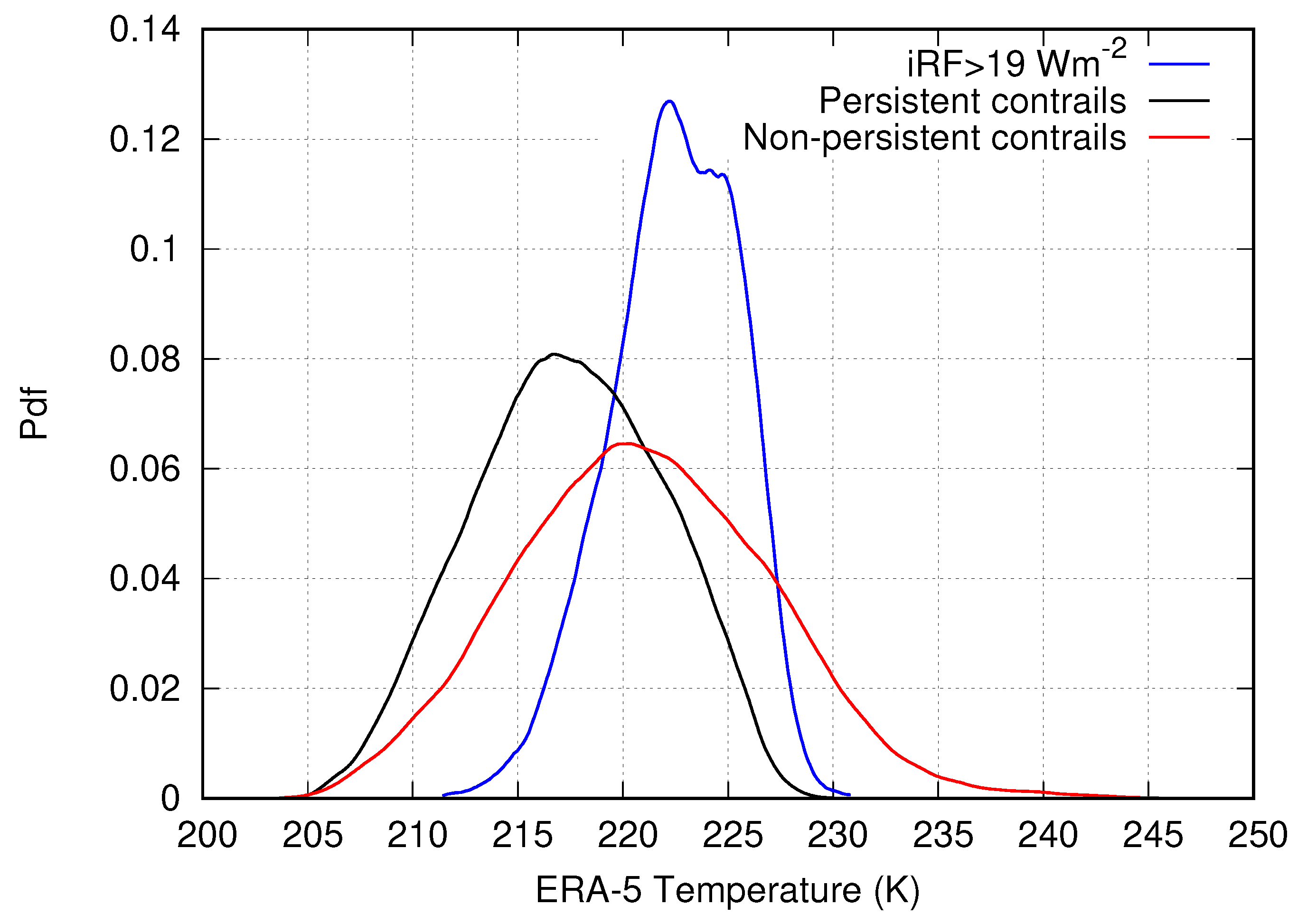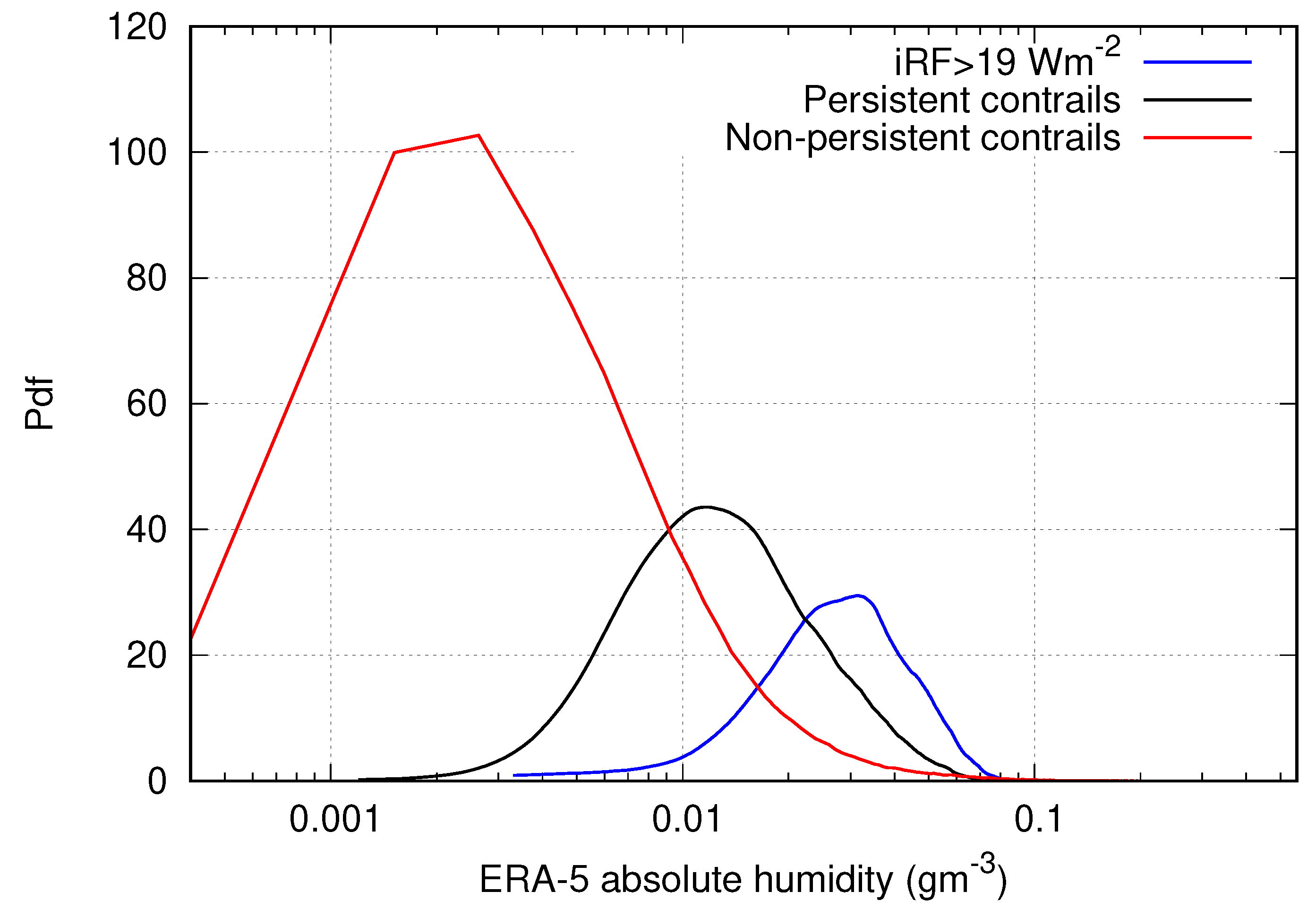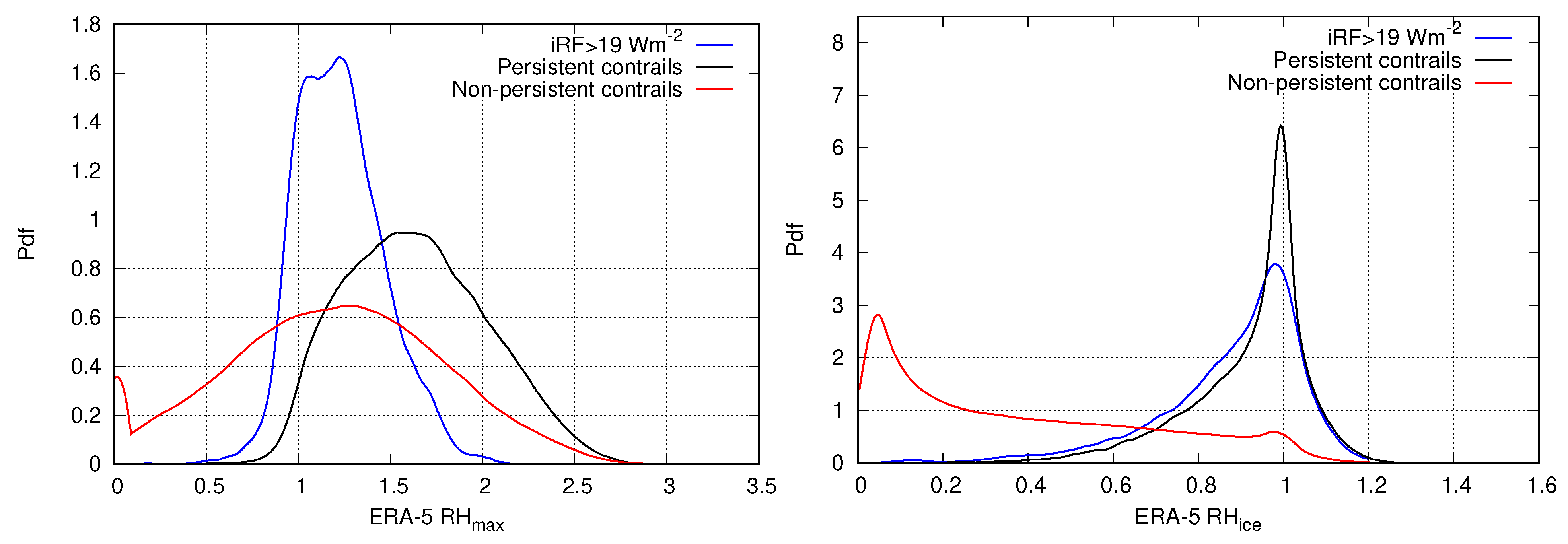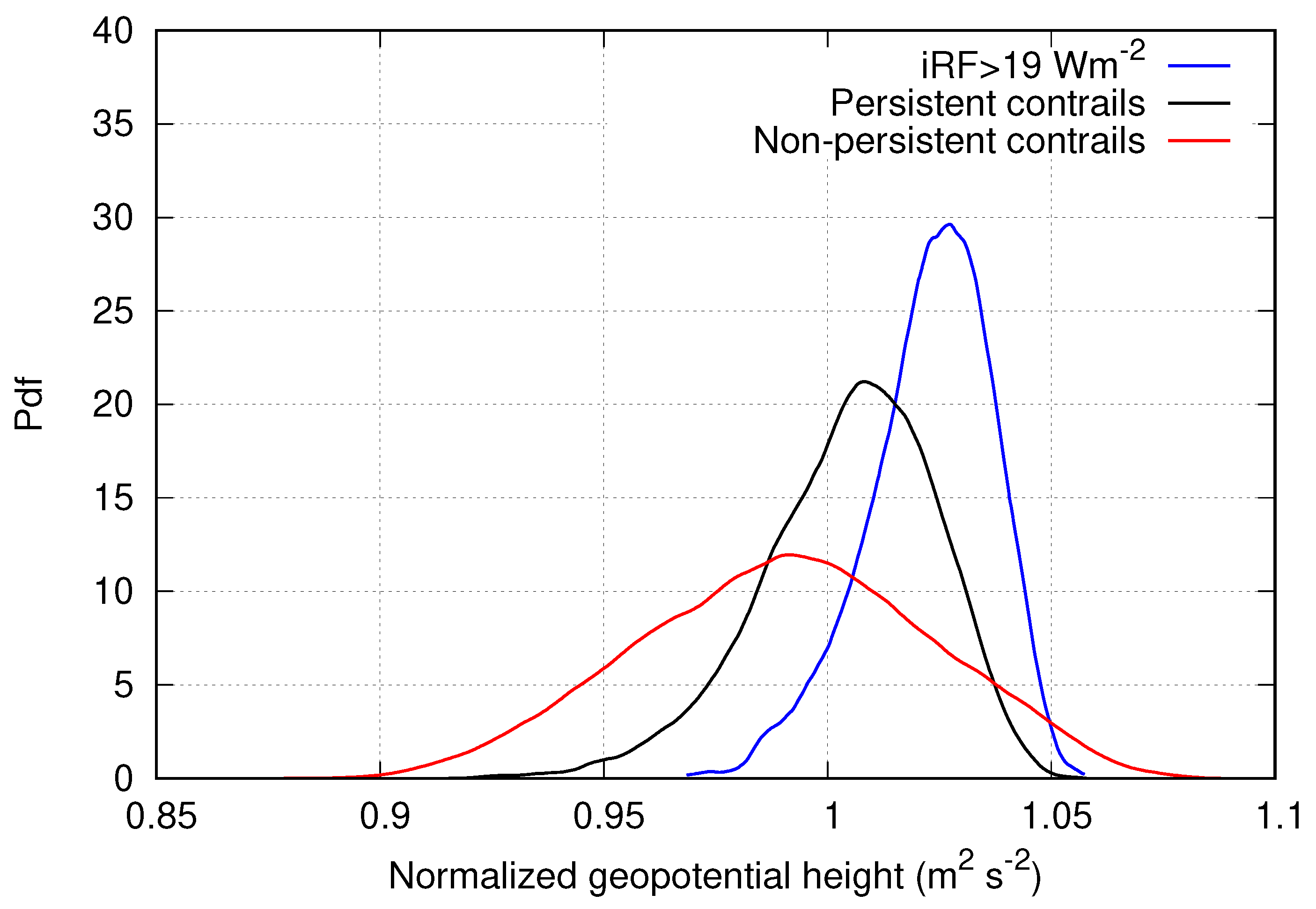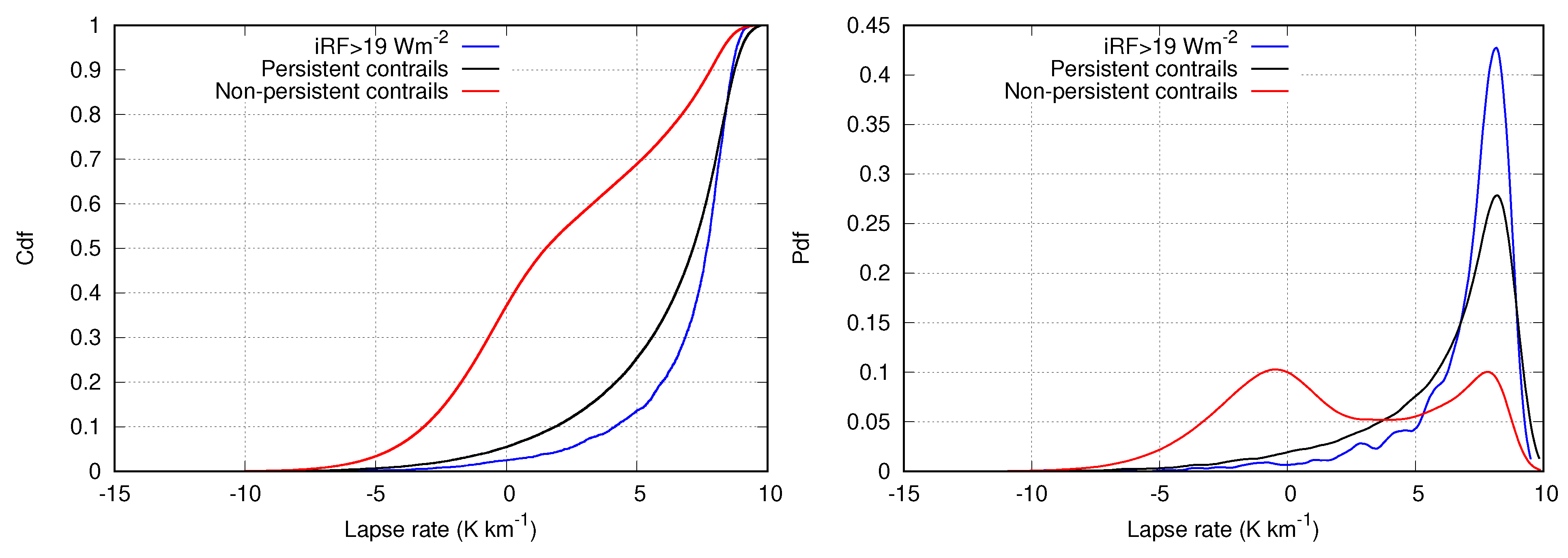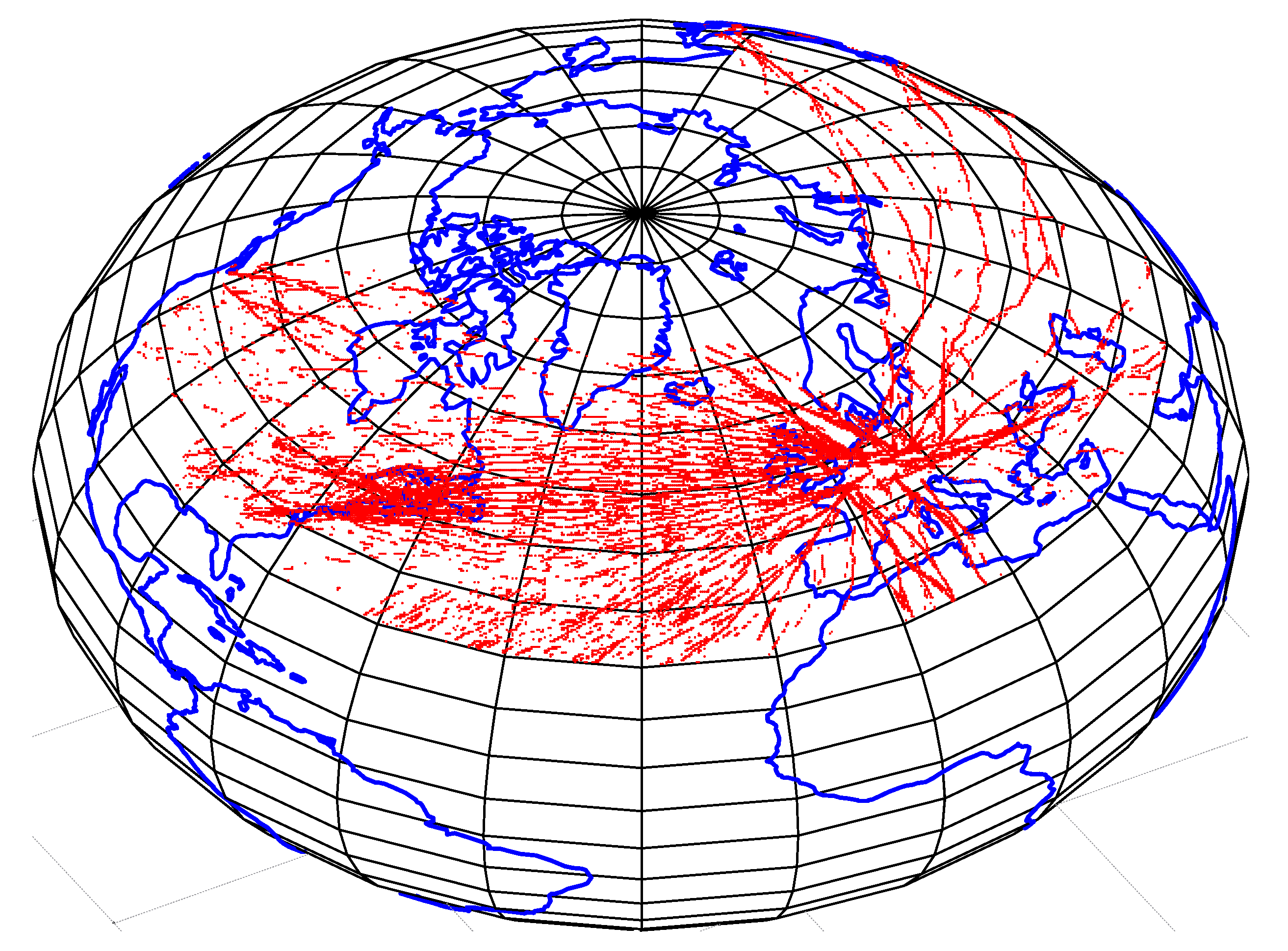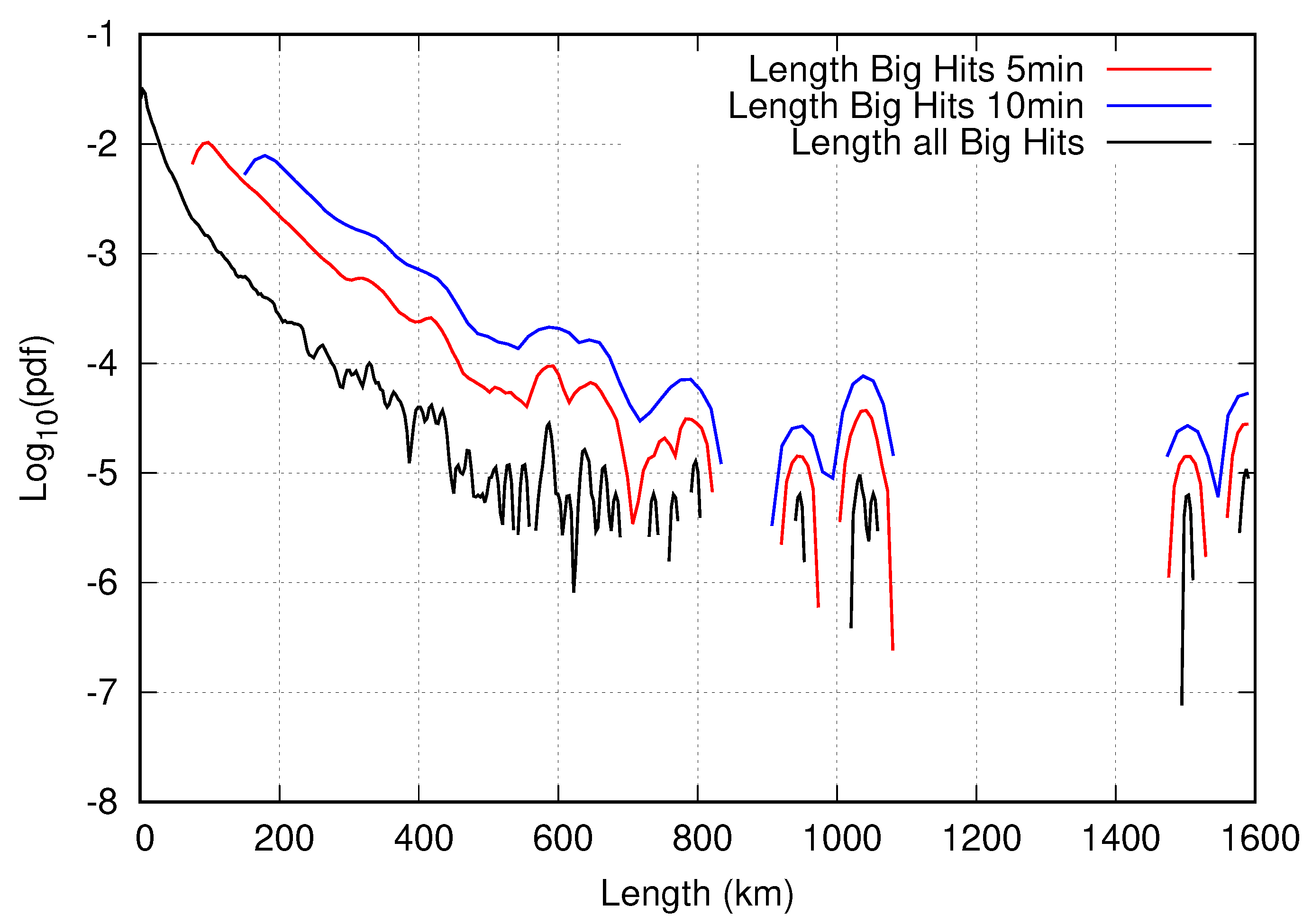3.1. Temperature and Humidity Fields
This chapter will compare distributions of thermodynamic variables for conditions where persistent contrails, persistent contrails with particularly large iRF, and non-persistent contrails (or no contrails) occur. “Particularly large iRF” means that iRF exceeds the ten-years average plus one standard deviation, which gives iRF
W m
. Contrails were distinguished according to MOZAIC data, such that the Schmidt-Appleman quantities
and
from the individual flight points decided whether a persistent contrail was possible. Here,
is the relative humidity (with respect to liquid water) that the mixture of exhaust gases with ambient air transiently attains at the moment when its temperature reaches the threshold for contrail formation.
must exceed unity for contrail formation to be possible (for the definition, see [
4]).
, the ambient relative humidity with respect to ice must exceed unity to allow contrail persistence. The distributions are given as probability density functions (pdf) that were produced with a kernel density estimator.
Figure 1 shows temperature distributions for the general situation (red, 390,486 cases), in situations that allow persistent contrails (black, 47032 cases), and in situations with large iRF (blue, 4052 cases). The pdfs show the temperatures from the ERA-5 reanalysis interpolated to the respective flight points from MOZAIC; however, the deciding factor for persistence (for all plots) are MOZAIC’s thermodynamic quantities. Only minimal differences between the temperature distributions of MOZAIC and ERA-5 are observed (not shown), indicating that ERA-5 predicts temperatures for the flight points from MOZAIC well. MOZAIC aircraft fly at temperatures between 200 and 250 K. Persistent contrails occur at the lower end of the distribution, and the Schmidt-Appleman threshold sets an upper limit for situations with contrails at about 230 K. Contrails with large iRF occur predominantly at temperatures a few degrees (say, 3 to 8 K) below the threshold, but not at the lowest temperatures that persistent contrails in our data attain. This is explained by the fact that absolute humidity generally increases with temperature, such that more ice can form and higher contrail optical thickness can be reached at higher temperatures, not too far below the contrail formation threshold.
Figure 2 confirms that contrails with large iRF particularly develop at the highest absolute humidities, as the pdf for this condition (blue line) is shifted relative to that for persistent contrails in general (black line) towards higher values.
In
Figure 3, pdfs for
and
are depicted. Remember that contrail formation and persistence is only possible when
and
. ERA-5 reanalysis can predict
quite well (see Figure 1 of [
4]), which is not surprising, as it depends predominantly on temperature. This, however, is not the case for relative humidity with respect to ice. Where MOZAIC diagnoses a persistent contrail with high
values above 1, ERA-5 has sometimes almost zero relative humidity (black and blue line). Such a misrepresentation of the local relative humidity is easily possible since the humidity field sometimes has quite strong gradients such that small shifts (spatial and/or temporal) of the modelled relative to the actual humidity field can cause such gross deviations. Large iRF values are generally facilitated by high supersaturation values, as that leads to higher optical thicknesses and, consequently, higher iRF. This fact is not represented in the distribution from ERA-5. The unreliable prediction of relative humidities in the upper troposphere and lower stratosphere is one of the reasons why contrail prediction is, so far, only possible at a regional scale and not for flight routing. An accurate prediction of the local conditions along a potential flight path would be necessary for this, which is not yet possible.
3.2. Dynamical Fields
Using dynamical variables for the prediction of persistent contrails and persistent contrails with large iRF could allow for an improvement. Not every variable is suited for this. Variables that have similar distributions for different conditions, e.g., ‘persistent contrail impossible’ and ‘persistent contrail possible’ are obviously not useful to distinguish between these conditions; they cannot be used as proxies. However, if a variable has distinct distributions for different conditions, then it can help to use this variable as a proxy for the prediction of persistent contrails. For instance, if a variable has values in a certain range only if there are no persistent contrails, then it is clear that a value in that range indicates that contrails need not be expected, and vice versa. Thus, we are looking for dynamical variables with distinctively different conditional distributions at least for the conditions ‘persistent contrail impossible’ and ‘persistent contrail possible’.
This subsection will therefore analyze distributions for vertical velocity, divergence, relative vorticity, potential vorticity, geopotential height, and the lapse rate. The dynamical quantities, except the lapse rate, were determined by interpolation from ERA-5 for each flight point from MOZAIC. The pdfs in
Figure 4,
Figure 5 and
Figure 6 are again given for persistent contrails, persistent contrails with large iRF, and for the general case where no persistent contrails appear.
The pdfs for vertical velocity (shown in pressure coordinates, that is, negative values indicate upward motion) are centred around zero (
Figure 4, top left). The range was restricted for a better distinction of the curves, excluding values with too low probability densities at the upper and lower end of the distribution. For persistent contrails, the distributions are slightly shifted towards the left, such that the mode values are negative. This favouring of ascending motion can be explained by the formation mechanism of ice-supersaturated regions (ISSRs), which are typically formed when air masses move upwards, where adiabatic cooling leads to an increase of relative humidity.
Similar to the vertical velocity, the pdfs of the divergence (
Figure 4, top right) are centred around zero as well, with the blue and back lines for persistent contrails and persistent contrails with large iRF slightly shifted towards positive values. Positive values indicate a divergence, and negative values a convergence, of air masses. As most ISSRs occur in a 200 hPa thick layer below the tropopause [
18], this shift is probably caused by the outwards spreading of air masses below the tropopause, which acts as a vertical boundary. The large
values in this layer promote the development of persistent contrails with high iRF. This is connected to the potential vorticity (
Figure 4, bottom right). The extratropical dynamical tropopause is typically found at the 2 PVU potential vorticity surface [
19] (1 PVU
K m
kg
s
), which is why the pdfs for persistent contrails have their peaks below that level. Contrails also develop in the lower stratosphere, but only rarely. The low probability densities at higher PV values of the blue and black function confirm this. Potential vorticity strongly increases in the stratosphere, which explains the difference in the pdf distribution for the general case.
The distributions for the relative vorticity (
Figure 4, bottom right) show a large separation between the pdf for the general case (red) and the other two functions. The pdfs for large-iRF (blue) and persistent contrails (black) are narrower and strongly concentrated on the negative side (anticyclonal, clockwise motion) compared to the general case, where the mode value of the distribution is clearly positive (anticlockwise motion). The results agree with [
7], since ISSRs also prefer divergent, anticyclonic flow. This variable may help to predict the persistence of contrails, but not to distinguish between persistent contrails of any iRF and those with large iRF, as their density functions still overlap substantially. The overlap in the distributions of the dynamical variables demonstrates that persistent contrails do not only develop during their favoured flow patterns. Only the relative frequency of the patterns is different within and outside of a situation where persistent contrails develop. Therefore, the dynamical fields vertical velocity, divergence, vorticity, and potential vorticity alone are not sufficient to improve the prediction of persistent contrails.
The distributions for the normalised geopotential height (
Z) (
Figure 5) display the largest separation so far. Persistent contrails are centred around higher
Z values (mode values exceeding 1) than cases without persistent contrails (mode value below 1). Persistent contrails with high iRF are more concentrated to the high values of
Z than persistent contrails in general; they are specifically found on the top altitudes of the pressure levels.
The variable that seems best suited for an improved prediction of the persistence of contrails is the local lapse rate. It describes the vertical temperature gradient and is a measure for the stability of the atmosphere (stratification). The difference between the three scenarios (persistence with large iRF, persistence, and non-persistence) is best visible when looking at the cumulative distribution functions (cdfs) in
Figure 6, left. The lapse rates range from about
to nearly 10 K km
. While roughly 70% of the cases that don’t allow persistent contrails or no contrails at all have a lapse rate below 5 K km
, such low values occur only in about 25% of situations that allow persistent contrails and even less (about 15%) so if the latter have a large iRF. However, 20% of persistent contrails occur in air masses with lapse rates exceeding about 8 K km
, and such high values do hardly occur in situations that do not allow contrail formation or persistence. Hence, persistent contrails and, in particular, persistent contrails with high iRF develop under rather high lapse rates with a weak stratification. Negative lapse rates occur with temperature inversions, which happen when the tropopause is close to the flight level. For physical explanations of the relation between ice supersaturation (i.e., contrail persistence) and high local lapse rates, see [
16].
Using the dynamical variables that showed the strongest separation (lapse rate, geopotential height, vorticity, and potential vorticity) and combining them with the Schmidt-Appleman quantities temperature and relative humidity could enable an improved prediction for contrail persistence based on atmospheric conditions along a flight. For the lapse rate and the geopotential height, the pdf of persistent contrails with large iRF is separated from the pdf of general persistent contrails. This could additionally allow a prediction of particularly strong warming contrails. Specifically avoiding those could reduce the overall radiative effect of contrail cirrus significantly [
8].
3.3. Path-Length Statistics for High Instantaneous Radiative Forcings and Big Hits
“Big Hits” are contrails with a very high individual energy forcing (EF), which is the integral of iRF over a contrail’s area and lifetime. Of course, these contrails are primary candidates for avoidance. Although we cannot determine EF-integrals from the single iRF values in our data set, we can get closer to EF by considering consecutive iRF values as they occur along a flight; that is, instead of probing a small sample of records as before, we now take all measured values into account. We use all data in order to find consecutive points along the flight tracks with an iRF value above the 19 W m threshold mentioned before (i.e., the iRF long term mean plus one standard deviation). A long track with high iRF values more likely forms a Big Hit than single scattered high-iRF records and avoidance of Big Hits by flight diversion is only feasible if they have a certain spatial extension.
To analyze this, a second dataset was produced from the ten years of MOZAIC’s flights with all data. Consecutive records with an iRF in excess of 19 W m are stored each in its own data file. If the threshold is undercut for a short distance of less than 10 data records (corresponding to 40 s of flight or about ten kilometres), we consider this a small fluctuation that does not interrupt a Big Hit; only if the gap is larger, we close the current file and proceed to the next record with an iRF in excess of the threshold. In this way, we find 13,955 Big Hits.
First, we check whether the so-defined Big Hits occur everywhere or perhaps only in special regions. For this, their coordinates are plotted on a world map (see
Figure 7) centred on the North-Atlantic flight corridor. This map gives only a weak indication of regions where Big Hits do not occur, where they are perhaps less probable over Greenland. Otherwise, the distribution of the red dots resembles the general distribution of MOZAIC flights within the considered mid-latitude belt. The distribution of red dots is more homogeneous in the main traffic regions than in less-frequented ones, probably because there are simply more data. In regions with fewer flights, the Big Hit locations seem to be a bit scattered or patchy along the track. This is likely caused by the strong variations in the atmospheric relative humidity field. When Big Hits do not always form as coherent tracks along the flight path, the question arises, whether, when, and where their avoidance by flight diversion makes sense. Preventing Big Hits is only effective if they do not appear pointwise and have more than a few kilometres in length. This length should be a not too small fraction of the mean path length of aircraft within ISSRs, that is, 150 km [
20].
To examine this, the path lengths of each of the 13,955 Big Hits were calculated, see
Figure 8. The majority (12,131) have a length less than 75 km (which translates to a flight duration of 5 minutes). Only 13% (1864) of Big Hits have an extension above 75 km and only 5% (660) have path lengths above 150 km. (Of course, these fractions depend on the chosen threshold iRF
W m
and the assumptions mentioned above). The path length distributions of Big Hits exceeding 75 km (red) and 150 km (blue) follow roughly an exponential decline for the first 600 to 800 km. The dataset contains one Big Hit exceeding 1500 km in length. Although those occur very rarely, their climate effect is above average (WGR21). Preventing the development of such contrails could make a huge difference. Ref. [
21] is a good example for that. In their data, about 2% of the flights in the Japanese airspace contributed to 80% of the energy forcing in the region (over a study period of six weeks in total).
However, it is also important to look at the coherence of the iRF itself. If the iRF changes strongly in a matter of seconds, it would not be possible to adjust the flight level accordingly.
Figure 9 shows the iRF along randomly chosen flights of different lengths. The coloured curves illustrate that the iRF jumps only weakly up and down from one flight point to another (4 s or 1 km apart) with an amplitude of approximately 5 W m
(blue, red, and green curves). Some of the curves (pink and orange) reveal strong fluctuations. This could be caused by a change in the surroundings along the flight path, e.g., by the presence of a natural cirrus or another contrail, or changing surface characteristics, e.g., when flying above a coast vs. above a dark ocean. Passing the terminator line, which separates day and night on the globe, could also induce such variations of iRF. In total, the results are encouraging, as the iRF does not constantly vary from a very high to a low value from one flight point to the next. Furthermore, for actual avoidance, one would consider integral values (e.g., EF) which are smoother than the underlying iRF time series. This is beneficial for flight diversion strategies.
3.4. Discussion
The iRF values necessary to distinguish Big Hits from weaker contrails are computed from the temperature and humidity measured by MOZAIC aircraft in cruise and ERA-5 radiation quantities interpolated to the aircraft positions (see WGR21). Thus, they refer to contrails
at the very moment of their formation. It is, however, not obvious that a large iRF of this kind implies a strongly warming contrail, that is, a contrail with a large energy forcing [
22]. If there is a correlation between iRF and EF, it is probably, at most, a weak one. A test calculation using a small data set by U. Schumann (private communication, 2021) did not yield a correlation, while a weak correlation between the initial contrail volume and ice mass to the integrated shortwave impact is indicated in [
23]. In any case, a large EF needs more than just a high iRF at the moment of contrail formation. EF includes the area a contrail spans in the sky and, in particular, the contrail life-time as well as the distribution of optical thickness over this area (both together can be combined into the so called total extinction, see [
24]). These factors cannot be captured by a single data record. Contrail lateral growth depends on the local vertical wind shear component perpendicular to the flight direction. While this quantity could be obtained from forecast or reanalysis data, it still does not suffice to determine the effective width for the EF calculation since the optical properties (from ice mass and ice number concentration) and the radiation background (e.g., other clouds and contrails, surface albedo) change during the expansion of the contrail in ways that are virtually unpredictable for a weather forecast model. The lifetime of a contrail depends on synoptic conditions and the growth rate and sedimentation of the ice crystals [
25].
Thus, the only connection of high local iRF values and actually strongly warming contrails, those with high EF values, can be seen in our cases with many consecutive high iRF values. It is probable that a >75 km track of high iRF values will coincide with a contrail of higher-than-average EF. Probably such a track crosses a larger area that allows a cluster of strong contrails if air traffic density there is sufficient e.g., [
26]. If Big Hits, in the EF sense, would predominantly occur in clusters, it should be easier to predict them as if they would occur in isolation. It is not required to know the air traffic in advance; likely it suffices to mark regions on the weather charts as regions of potential Big Hits, and the demarcation of such regions would involve the conditional distributions determined in this paper combined with the radiation parameterisation of [
15]. Only the estimation of contrail optical thicknesses (which needs the actual supersaturation value) is not straightforward since, for the prediction purpose, one is restricted to the forecasted humidity field. Thus, it is not sufficient to predict ice supersaturation per se but also to estimate a mean or maximum degree of ice supersaturation in a predicted ISSR. This is still an open issue for future work.
